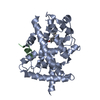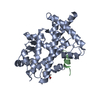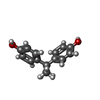Entry Database : PDB / ID : 9f7wTitle Human PPARgamma ligand binding domain in complex with co-activator 1alpha peptide and bisphenol A (BPA) Peroxisome proliferator-activated receptor gamma Peroxisome proliferator-activated receptor gamma coactivator 1-alpha Keywords / / / Function / homology Function Domain/homology Component
/ / / / / / / / / / / / / / / / / / / / / / / / / / / / / / / / / / / / / / / / / / / / / / / / / / / / / / / / / / / / / / / / / / / / / / / / / / / / / / / / / / / / / / / / / / / / / / / / / / / / / / / / / / / / / / / / / / / / / / / / / / / / / / / / / / / / / / / / / / / / / / / Biological species Homo sapiens (human)Method / / / Resolution : 1.25 Å Authors Useini, A. / Strater, N. Funding support Organization Grant number Country German Research Foundation (DFG) 209933838 German Research Foundation (DFG) 421152132
Journal : Biomolecules / Year : 2024Title : Structural Studies on the Binding Mode of Bisphenols to PPAR gamma.Authors : Useini, A. / Schwerin, I.K. / Kunze, G. / Strater, N. History Deposition May 5, 2024 Deposition site / Processing site Revision 1.0 Jul 10, 2024 Provider / Type Revision 1.1 Aug 20, 2025 Group / Category / structItem / _struct.title
Show all Show less
 Yorodumi
Yorodumi Open data
Open data Basic information
Basic information Components
Components Keywords
Keywords Function and homology information
Function and homology information Homo sapiens (human)
Homo sapiens (human) X-RAY DIFFRACTION /
X-RAY DIFFRACTION /  SYNCHROTRON /
SYNCHROTRON /  FOURIER SYNTHESIS / Resolution: 1.25 Å
FOURIER SYNTHESIS / Resolution: 1.25 Å  Authors
Authors Germany, 2items
Germany, 2items  Citation
Citation Journal: Biomolecules / Year: 2024
Journal: Biomolecules / Year: 2024 Structure visualization
Structure visualization Molmil
Molmil Jmol/JSmol
Jmol/JSmol Downloads & links
Downloads & links Download
Download 9f7w.cif.gz
9f7w.cif.gz PDBx/mmCIF format
PDBx/mmCIF format pdb9f7w.ent.gz
pdb9f7w.ent.gz PDB format
PDB format 9f7w.json.gz
9f7w.json.gz PDBx/mmJSON format
PDBx/mmJSON format Other downloads
Other downloads 9f7w_validation.pdf.gz
9f7w_validation.pdf.gz wwPDB validaton report
wwPDB validaton report 9f7w_full_validation.pdf.gz
9f7w_full_validation.pdf.gz 9f7w_validation.xml.gz
9f7w_validation.xml.gz 9f7w_validation.cif.gz
9f7w_validation.cif.gz https://data.pdbj.org/pub/pdb/validation_reports/f7/9f7w
https://data.pdbj.org/pub/pdb/validation_reports/f7/9f7w ftp://data.pdbj.org/pub/pdb/validation_reports/f7/9f7w
ftp://data.pdbj.org/pub/pdb/validation_reports/f7/9f7w
 F&H Search
F&H Search Links
Links Assembly
Assembly
 Components
Components Homo sapiens (human) / Gene: PPARG, NR1C3 / Production host:
Homo sapiens (human) / Gene: PPARG, NR1C3 / Production host: 
 Homo sapiens (human) / References: UniProt: Q9UBK2
Homo sapiens (human) / References: UniProt: Q9UBK2 X-RAY DIFFRACTION / Number of used crystals: 1
X-RAY DIFFRACTION / Number of used crystals: 1  Sample preparation
Sample preparation SYNCHROTRON / Site:
SYNCHROTRON / Site:  PETRA III, EMBL c/o DESY
PETRA III, EMBL c/o DESY  / Beamline: P14 (MX2) / Wavelength: 0.97625 Å
/ Beamline: P14 (MX2) / Wavelength: 0.97625 Å Processing
Processing FOURIER SYNTHESIS / Resolution: 1.25→41.88 Å / SU ML: 0.1249 / Cross valid method: FREE R-VALUE / σ(F): 1.34 / Phase error: 23.9806
FOURIER SYNTHESIS / Resolution: 1.25→41.88 Å / SU ML: 0.1249 / Cross valid method: FREE R-VALUE / σ(F): 1.34 / Phase error: 23.9806  Movie
Movie Controller
Controller


 PDBj
PDBj










